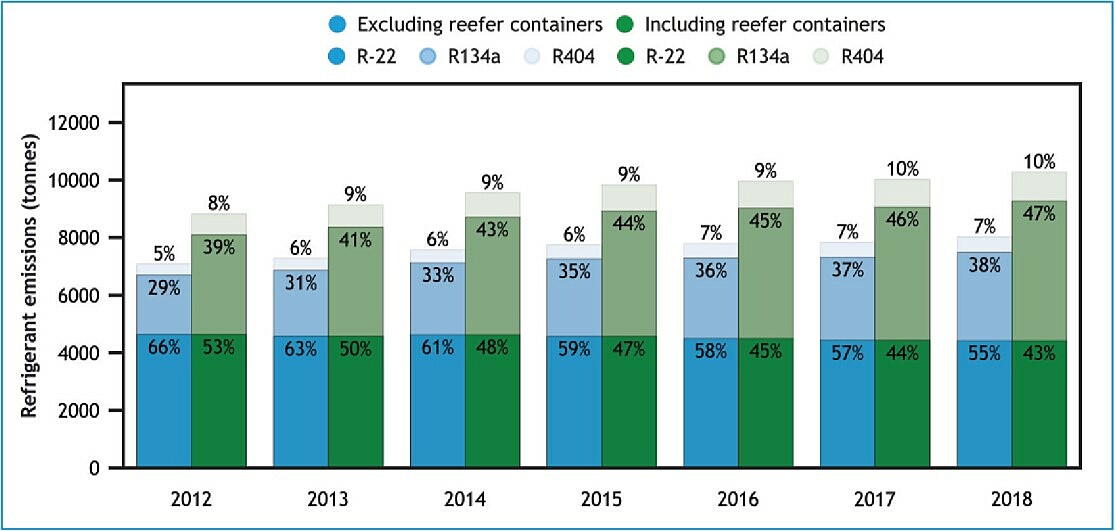GHG emissions in international marine shipping.
GHG emissions from international shipping increased by 9.6% between 2012 and 2018, according to the Fourth Greenhouse Gas Study published in 2020 by the International Maritime Organization. HFC and HCFC emissions from refrigeration and air conditioning activities on board were also estimated.
According to the latest Greenhouse Gas Study published in 2020 by the International Maritime Organization (IMO), the greenhouse gas (GHG) emissions from total shipping (international, domestic and fishing) increased by 9.6%, from 977 million tonnes of CO2eq in 2012 to 1,076 million tonnes of CO2eq in 2018. The share of shipping emissions in global emissions increased from 2.76% in 2012 to 2.89% in 2018.
Fuel consumption in international marine shipping [1]
Consistent with the previous IMO GHG Study published in 2014, energy use for propulsion remains the primary demand for energy across the majority of ship types.
For international shipping, heavy fuel oil remains the dominant fuel. Nevertheless, between 2012 and 2018, the proportion of heavy fuel oil consumption decreased by 3%, while the share of liquefied natural gas (LNG) consumption grew by 26%. When taking into account international shipping, inland shipping and fishing vessels, fuel consumption shows similar trends to those of international shipping. Heavy fuel oil consumption decreased slightly by 3.5%, whilst LNG consumption increased by 23.4%.
The trends in average fuel consumption over the period 2012-2018 varied significantly between ship types. For many ship types, notably for cruise ships, ferries and reefer bulk vessels , fuel consumption decreased consistently. Consequently, over the study period, most ship types experienced a reduction in average GHG emissions per vessel, despite an increase in total GHG emissions. Indeed, the evolution in total GHG emissions is a function of the total number of ships.
Refrigerant emissions from ships [1,2]
The report also presents emissions from non-combustion sources, such as HFC and HCFC emissions from air conditioning (e.g. on passenger ships), and from refrigeration activities (e.g. chilling and freezing of harvested fishery products).
Total emissions of refrigerants commonly used in shipping correspond to 18.2 million tonnes of CO2-eq, which is an increase from the 15.7 million tonnes of CO2-eq emitted in 2012. [1]
For comparison purposes, the IIR had estimated that emissions of refrigerants for the refrigeration sector as a whole represented 1567 million tonnes of CO2-eq in 2016. [2]
According to the authors of the IMO report, HCFCs (R22) are still used for both air conditioning and cooling in older vessels built before 2000. Newer vessels use HFCs: R134a for air conditioning and R404A for refrigeration. The results showed a continued reduction in the share of R22.

GHG emission projections for 2018 – 2050
The COVID-19 pandemic has greatly affected international shipping and the authors of the study assume that GHG emissions for 2020 and 2021 will be significantly reduced. However, when considering long-term business-as-usual scenarios, shipping emissions are projected to increase by up to 50% from 2018 levels, which would represent an increase of 90-130% from 2008 levels.
Sources
[1] Fourth Greenhouse Gas Study 2020 by International Maritime Organization. https://www.imo.org/en/OurWork/Environment/Pages/Fourth-IMO-Greenhouse-Gas-Study-2020.aspx
[2] IIR. The impact of the refrigeration sector on climate change, 35th Informatory Note on refrigeration technologies. Available for download from FRIDOC: https://iifiir.org/en/fridoc/the-impact-of-the-refrigeration-sector-on-climate-change-141135
